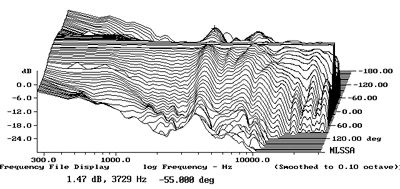If there is no compression chamber then it isn't a horn. It's pretty simple. This speaker just has a large waveguide.
Actual horn
Actual horn
Last edited:
If those graphs are accurate, they just clearly indicate that the crossover is badly designed. It's nothing new. It's a fact that many speaker manufacturers don't have the qualified personnel to design smooth passive crossovers. The curves clearly show that the woofer response start to slope down at a too low frequency, whereas the tweeter's knee frequency is too high, so their responses fail to properly cross at a specified frequency.
Yah one of the forum members reviewed the active BW DUO and the measurements kinda were crap. All the DSP available and they still don't go for flat. They have a whole other thing going. Not sure what their intent is but is something...
That is what happens in all reviews of all makes.PS. I haven`t shared Amirs review at Klipsch forum yet. If someone is brave enough.. Usually it leads to "there must be something wrong about the data.." and bashing.
The RP600M's tweeter and woofer are connected in the same polarity - see fig.7 at https://www.stereophile.com/content/klipsch-reference-premiere-rp-600m-loudspeaker-measurements - and while fig.4 at that URL shows the acoustic crossover slopes, 4th-order high-pass on the tweeter, close to 3rd-order low-pass on the woofer, it doesn't show the phase of the drive-units in the crossover region.
Yep. If we look at the predicted in-room response, this will tell us whether the emphasis >10kHz will cause “fizziness”.Hi Amir, when you write in this graph “Peaking above 10kHz will sound bright,” that hasn't been my experience. Excess energy in the top octave, if also present off-axis, tends to add "air" or fizziness and lispiness if extreme. If the excess above 10kHz is small and the tweeter's dispersion is limited in this region (as they almost all are), then it can actually result in a neutral top-octave balance in all but small rooms. Brightness, I have found, tends to be due to too much energy between 5kHz and 10kHz.
John Atkinson
Technical Editor, Stereophile
With thanks to Mr. Atkinson, this concludes the Klipsch RP-600M frequency response was deliberately tailored with dip between 1 and 3 kHz.
That doesn't make sense.Or maybe this was the best that they could do with the available drivers.
Klipsch sells the floor standing model of this and GR research also found a big dip in it!That doesn't make sense.
Am I confused, or do Amir and Joe seem to have reached opposite conclusions about this speaker?
A sub can't fix this mess....should be more like 4.1 with a sub.
What then do you call those audiophile highend horn speakers which have no compression chamber?If there is no compression chamber then it isn't a horn. It's pretty simple. This speaker just has a large waveguide.
Actual horn
Klipsch sells the floor standing model of this and GR research also found a big dip in it!
As are the GR research measurements shown in the video earlier.
Without specifically stating what it means, he basically said that these speakers only sound good when you toe them in and align your ears perfectly in line with a spot between the tweeter and woofer. I don't want speakers that require such a narrowly defined listening position.
However, that conclusion seems to conflict with Amir's review that said "The 'horn' is actually not a horn but a waveguide that is doing its job to provide uniform off-axis response allowing one to EQ the mid-range dip."
Am I confused, or do Amir and Joe seem to have reached opposite conclusions about this speaker?
The actual BBC dip for the LS3/5A was at 3700Hz.The "BBC" presence dip is usually a bit higher, often between 2-3 or 2.5-4 kHz.

The actual BBC dip for the LS3/5A was at 3700Hz.
Also, so many people wrongly use the dip that was added to that speaker as proof that flat on-axis is not preferred. The dip was added as that speaker peaked heavily off-adis at 3700Hz:

I think the answer to that really has to be yes. From the research it's pretty clear the biggest contributions to sound quality are a flatish on axis response and smooth off axis curves. When EQ is in the equation, this would tend to mean the directivity curve is the most important measurement of a speaker. A speaker with poor directivity control that may have flatter on-axis response out of the box will be stuck with uneven off axis curves, while a speaker with an uneven frequency response out of the box but a smooth directivity curve can be corrected much closer to ideal than the first speaker will ever get.I think this highlights an interesting case where, once EQ comes in to the equation, the speaker actually ends up being better than quite a few speakers that measure better pre-eq. Does that make it a better speaker? I'm not sure how I feel on that. As someone who uses Dirac Live, the answer for me - personally - probably should be yes, but I still don't really like that answer for some reason.
